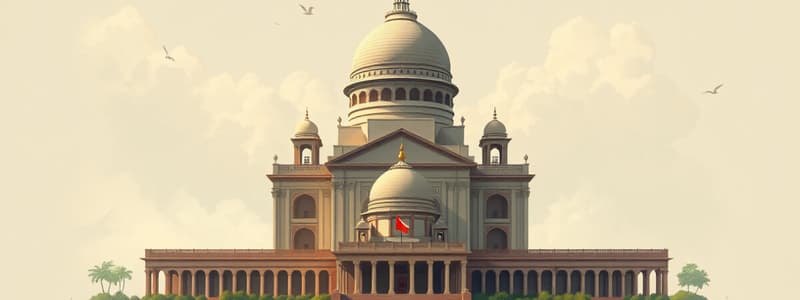Podcast
Questions and Answers
According to _______________, 'Constitution' means the system of fundamental political institutions or an autobiography of power relationship.
According to _______________, 'Constitution' means the system of fundamental political institutions or an autobiography of power relationship.
G.C. Lewis
The Government of India Act, 1935 provided for:
The Government of India Act, 1935 provided for:
- Diarchy at the center
- Establishment of federal Court
- Provincial Autonomy
- All of the above (correct)
India is referred as __________ under the Indian constitution.
India is referred as __________ under the Indian constitution.
Bharat
India has been declared under Article 1 of the Indian Constitution as a:
India has been declared under Article 1 of the Indian Constitution as a:
The Constitution of India declares India as:
The Constitution of India declares India as:
The Constitution of India describes India as a:
The Constitution of India describes India as a:
East India Company was established in the year:
East India Company was established in the year:
Minto Morley reforms implemented by the Indian Council Act in:
Minto Morley reforms implemented by the Indian Council Act in:
The plan of setting up of a Constituent Assembly to draw up the future Constitution for India was given by:
The plan of setting up of a Constituent Assembly to draw up the future Constitution for India was given by:
Diarchy means a system of:
Diarchy means a system of:
The President of the Constituent Assembly was:
The President of the Constituent Assembly was:
The Members of the Constituent Assembly were:
The Members of the Constituent Assembly were:
The Constituent Assembly appointed________ on 29th Aug. 1947, as Chairman of the Constitution Drafting Committee.
The Constituent Assembly appointed________ on 29th Aug. 1947, as Chairman of the Constitution Drafting Committee.
Chairman of the Constituent Assembly was and the Chairman of the Constitution Drafting Committee was:
Chairman of the Constituent Assembly was and the Chairman of the Constitution Drafting Committee was:
The number of Articles in the Indian Constitution was and is:
The number of Articles in the Indian Constitution was and is:
How much time did the Constituent Assembly take to prepare the Constitution of India?
How much time did the Constituent Assembly take to prepare the Constitution of India?
Who among the following was not a member of the Drafting Committee?
Who among the following was not a member of the Drafting Committee?
The Constitution of India was adopted on and came into effect on:
The Constitution of India was adopted on and came into effect on:
Indian constitution came into force on:
Indian constitution came into force on:
Who made and adopted the Indian constitution?
Who made and adopted the Indian constitution?
The Cabinet mission came to India in:
The Cabinet mission came to India in:
The Constituent Assembly of India started its work in 1946 and completed its work in:
The Constituent Assembly of India started its work in 1946 and completed its work in:
The famous Dandi March done by Mahatma Gandhiji was against:
The famous Dandi March done by Mahatma Gandhiji was against:
Flashcards are hidden until you start studying
Study Notes
Making of the Constitution
- Constitution Definition: Describes the Constitution as a system of fundamental political institutions, highlighting the power relationships.
- Government of India Act, 1935: Introduced diarchy at the center, established a federal court, and provided provincial autonomy.
- India's Name in Constitution: Officially refers to the country as Bharat.
- Union of States: Article 1 states India is a Union of States rather than a confederation or federation, indicating a strong central authority.
- Status Under Constitution: The Constitution declares India as a union of states and embodies quasi-federal characteristics.
Historical Context
- East India Company Establishment: Founded in 1600, marking the beginning of significant British involvement in India.
- Minto Morley Reforms: Instituted by the Indian Council Act of 1909, aiming to improve governance in British India.
- Constituent Assembly Formation: The plan for a Constituent Assembly was proposed by the Cabinet Mission Plan.
- Diarchy: Refers to a system of double government, where powers are shared between centralized and provincial governments.
Key Figures and Assembly Process
- President of Constituent Assembly: Dr. Rajendra Prasad chaired the assembly.
- Members' Selection: Members were elected by provincial assemblies, not directly by the people.
- Chairman of Drafting Committee: Dr. B.R. Ambedkar was appointed as the chairman on August 29, 1947.
- Distinction of Roles: Dr. Rajendra Prasad was both the President of the Constituent Assembly and the eventual first President of India.
Constitution Development and Adoption
- Number of Articles: The original Constitution comprised 395 articles, later amended.
- Duration of Drafting: The Constituent Assembly spent 2 years, 11 months, and 18 days crafting the Constitution.
- Drafting Committee Member Exclusion: Dr. Rajendra Prasad was not a member of the Drafting Committee.
- Adoption and Enforcement Dates: The Constitution was adopted on November 26, 1949, and came into effect on January 26, 1950.
Governance Framework
- Making of the Constitution: Crafting and adopting occurred solely through the Constituent Assembly, distinct from the British Parliament.
- Cabinet Mission Arrival: The Cabinet Mission visited India in 1946 to negotiate the political future, leading to Constituent Assembly formation.
- Constituent Assembly Timeline: It commenced its work in 1946 and completed it by November 1949.
Social Movements
- Dandi March: Led by Mahatma Gandhi as a protest against the British salt tax, symbolizing resistance to oppressive rule.
Studying That Suits You
Use AI to generate personalized quizzes and flashcards to suit your learning preferences.




